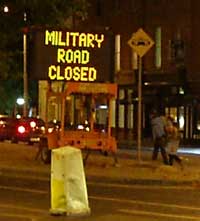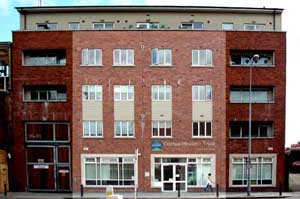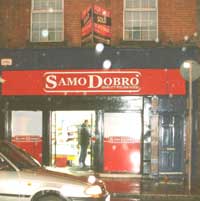Consultation 18 October 2007

The Event
This was the third in a series of neighbourhood consultations on Dublin City Council's plans for the regeneration of the Liberties. The process had been launched on 8 October. This consultation was held in St. James's Parish Hall and concentrated on the area surrounding the old harbour/basin. The outcome of the three neighbourhood consultations and of contacts with planners, developers and councillors will feed into a jumbo meeting of all the stakeholders in St. Catherine's church, on 9 and 10 November 2007. You can view the flyer for this meeting here.
The organisation of theconsultations has been entrusted by the City Council to an English firm John Thompson Partners. The team is led by Clare San Martin and she was in charge of this consultation.
The Method
Most of the people who turned up were expecting to face a forceful presentation of the Council's plans for the area. Instead we were faced by some blank wallboards and an unlimited supply of post-it notes. The boards were headed: Problems; Dreams; Solutions; and the idea was to canvass the thoughts of those present in a completely undirected way. Each post-it note was to contain one simple idea confined to a few words.
It took a while to get the hang of this method of operation but with a little encouragement the post-it notes began to flow and the wallboards were rapidly filling up. In some cases contributors expanded orally on what they had written, in others the headline notes were self-explanatory.
The Substance
- Local Residents
 The first point the locals made was that they had been through this sort of thing many times before and without any useful result. With all due respect to the English visitors, this was a box ticking exercise and the Council would go ahead and do their own thing in any event. The developers would carry the day; it was already a done deal. The Council was said to have informally told some residents that it couldn't be seen to be helping private houseowners (particularly in one case where there were only eight of them).
The first point the locals made was that they had been through this sort of thing many times before and without any useful result. With all due respect to the English visitors, this was a box ticking exercise and the Council would go ahead and do their own thing in any event. The developers would carry the day; it was already a done deal. The Council was said to have informally told some residents that it couldn't be seen to be helping private houseowners (particularly in one case where there were only eight of them). There was a general feeling that the area was bearing more than its share of Dublin's rehabilitation efforts with needle exchanges, drop ins, and now a wet house. At the same time private developers were eating up local facilities (eg club premises) with no payback (eg replacement). As most of the available space in the area was already pre-empted it was suggested that one existing appartment block be returned to community use.
The granting of permission for high rise development without any plan for resulting traffic was seen as a measure of the Council's lack of concern for those living in this already congested area. They wondered if dereliction was being allowed, or even encouraged, to facilitate developers. More Gardaí were needed in the area. They came when you called them but otherwise they were not around.
- Local Councillor
A local councillor heaped all the blame for the area's ills on Central Government, in which she included An Bord Pleanála. Central Government was starving the Council of both power and funding. Council decisions were being overturned by the Bord. The solution was more power to the Council. At the same time she was very defensive of the Council, citing some €2 million in funding raised from developers which had been distributed locally to clubs and the like.
- Parish Priest
 PP referred to the deterioration of community in the area. He had been attacked three times in the church by people looking for money. People were urinating in the church, and he had recently had to install cameras at a cost of thousands.
PP referred to the deterioration of community in the area. He had been attacked three times in the church by people looking for money. People were urinating in the church, and he had recently had to install cameras at a cost of thousands. High rise apartment building was rampant without any consideration of the traffic implications. An eight storey glass appartment development was going up beside the church without any thought for where the occupants would park. Echlin street was already a bottleneck . Now the Military Road had been closed virtually without notice and the traffic backup had increased enormously.
When the Celtic Tiger passed the area would turn into slums. A return to the 1900s. He also reminded the team that there was a whole new town being developed around Heuston Station.
- School Principals
One local school Principal stressed the need for mixed development, green spaces, facilities and planning. Communities could not develop if people had nowhere to congregate and if people did not walk through their own area. The area had deteriorated to the point where people were driving rather than walking even short distances. Facilities would need to be managed on a full time basis if they were not to deteriorate through neglect or be taken over by druggies. The harbour/basin area, which was probably the only place new community facilities could be located, was already either bought up or being chased by developers. While it was accepted that there would always be some movement of people in and out of the area, a mainly transient population was not a basis for developing communities. A significant proportion of the residents would need to be permanent.
 Another local Principal maintained that the local education system had totally failed the area. The national and secondary schools were not working and locals could not afford to attend the institutes in the area which catered for the non-indigenous population. Nor were they in a position to set up their own schools as many residents of middle class areas are now doing (Educate Together, Gaelscoileanna etc.) . Only 3% of secondary leavers were going on to third level. The existing schools needed to be taken from church, be converted into mixed gender schools, streamed and be managed by, for instance, the Council itself. The public sector had already financed these schools which nevertheless remained in the ownership and control of the church.
Another local Principal maintained that the local education system had totally failed the area. The national and secondary schools were not working and locals could not afford to attend the institutes in the area which catered for the non-indigenous population. Nor were they in a position to set up their own schools as many residents of middle class areas are now doing (Educate Together, Gaelscoileanna etc.) . Only 3% of secondary leavers were going on to third level. The existing schools needed to be taken from church, be converted into mixed gender schools, streamed and be managed by, for instance, the Council itself. The public sector had already financed these schools which nevertheless remained in the ownership and control of the church.Locals had not benefitted from jobs in local development either in construction or otherwise. One accountancy firm wanted a "computer literate tea-lady". Needless to say that didn't go to a local. The local educational system was not producing the level of people required in today's world.
- Non resident
One non-resident pointed out that there is an influx of 800,000 visitors a year to the Guinness Hopstore in the heart of the area but there is no benefit to the area itself. They come on the bus, leave on the bus, and are encouraged not to wander. The area needs to develop attractions to capture some of this traffic/trade. It also needed to be better signposted and presented to the tourist.
Comment
The fact that the team leading the consultation were from out of town was a minus, at least to begin with. I had a feeling the locals thought the Council was avoiding them and foisting the team on them instead. The team did seem to be trying to do a reasonable job and their company website would encourage you, if you could take it at face value. On the other hand the Council is the one employing them. I don't think the team gained any brownie points by pointing out that they had flown one of their number in from Berlin.
However, after a somewhat tentative start the team and its method seemed to go down relatively well. And the later discussions, around small tables with a large area plan as a reference point, were lively and productive.
 Advance notice of the meeting had been a problem. The team said they had given some thousands of flyers to An Post which had undertaken to deliver them throughout the area but none of those present seem to have got one. If they had, they might not have been impressed with the phone contact number given being a London number. The team commited to a smarter distribution of notice of the next meeting.
Advance notice of the meeting had been a problem. The team said they had given some thousands of flyers to An Post which had undertaken to deliver them throughout the area but none of those present seem to have got one. If they had, they might not have been impressed with the phone contact number given being a London number. The team commited to a smarter distribution of notice of the next meeting.The proposed joining up of the two Luas lines will cut a swathe through the area and could contribute to some isolation of communities. On the positive side it might cut down on car traffic and at the same time bring more tourists into the area. This element did not arise until the later discussions in smaller groups.
In view of the current ethnic mix of the area I expected some ethnic mix in the participants but as far as I could make out the participation from local residents was all from the oul stock.
The team took lots of photos of the proceedings which will no doubt figure in subsequent reports as an illustration of the high degree of local participation. This could be positive if local views are taken on board but will otherwise be a very cynical aspect of the consultation.
A critical question in all of this is whether the pass has already been sold, including over the last decade or two, and whether it might now be too late to salvage or encourage any viable communities in the area.
Bounded on the north by James's/Thomas St., south by Cork St.,
west by the hospital and east by Francis St.
